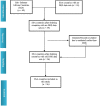Caesarean delivery and its association with educational attainment, wealth index, and place of residence in Sub-Saharan Africa: a meta-analysis
- PMID: 35365718
- PMCID: PMC8975863
- DOI: 10.1038/s41598-022-09567-1
Caesarean delivery and its association with educational attainment, wealth index, and place of residence in Sub-Saharan Africa: a meta-analysis
Abstract
Caesarean delivery (C-section) has been increasing worldwide; however, many women from developing countries in Sub-Saharan Africa are deprived of these lifesaving services. This study aimed to explore the impact of certain socioeconomic factors, including respondent's education, husband's education, place of residence, and wealth index, on C-section delivery for women in Sub-Saharan Africa. We used pooled data from 36 demographic and health surveys (DHS) in Sub-Saharan Africa. Married women aged 15-49 years who have at least one child in the last five years were considered in this survey. After inclusion and excluding criteria, 234,660 participants were eligible for final analysis. Binary logistic regression was executed to determine the effects of selected socioeconomic factors. The countries were assembled into four sub-regions (Southern Africa, West Africa, East Africa, and Central Africa), and a meta-analysis was conducted. We performed random-effects model estimation for meta-analysis to assess the overall effects and consistency between covariates and utilization of C-section delivery as substantial heterogeneity was identified (I2 > 50%). Furthermore, the meta-regression was carried out to explain the additional amount of heterogeneity by country levels. We performed a sensitivity analysis to examine the effects of outliers in this study. Findings suggest that less than 15% of women in many Sub-Saharan African countries had C-section delivery. Maternal education (OR 4.12; CI 3.75, 4.51), wealth index (OR 2.05; CI 1.94, 2.17), paternal education (OR 1.71; CI 1.57, 1.86), and place of residence (OR 1.51; CI 1.44, 1.58) were significantly associated with the utilization of C-section delivery. These results were also consistent in sub-regional meta-analyses. The meta-regression suggests that the total percentage of births attended by skilled health staff (TPBASHS) has a significant inverse association with C-section utilization regarding educational attainment (respondent & husband), place of residence, and wealth index. The data structure was restricted to define the distinction between elective and emergency c-sections. It is essential to provide an appropriate lifesaving mechanism, such as C-section delivery opportunities, through proper facilities for rural, uneducated, impoverished Sub-Saharan African women to minimize both maternal and infant mortality.
© 2022. The Author(s).
Conflict of interest statement
The authors declare no competing interests.
Figures






Similar articles
-
Effect of maternal height on caesarean section and neonatal mortality rates in sub-Saharan Africa: An analysis of 34 national datasets.PLoS One. 2018 Feb 6;13(2):e0192167. doi: 10.1371/journal.pone.0192167. eCollection 2018. PLoS One. 2018. PMID: 29408912 Free PMC article.
-
Spatial patterns and inequalities in skilled birth attendance and caesarean delivery in sub-Saharan Africa.BMJ Glob Health. 2021 Oct;6(10):e007074. doi: 10.1136/bmjgh-2021-007074. BMJ Glob Health. 2021. PMID: 34716145 Free PMC article.
-
Caesarean section and subsequent fertility in sub-Saharan Africa.BJOG. 2006 Mar;113(3):276-83. doi: 10.1111/j.1471-0528.2006.00846.x. BJOG. 2006. PMID: 16487198
-
Inequality of child mortality among ethnic groups in sub-Saharan Africa.Bull World Health Organ. 2000;78(1):30-41. Bull World Health Organ. 2000. PMID: 10686731 Free PMC article. Review.
-
Current findings and gaps in early initiation of breastfeeding practices in sub-Saharan African countries: A scoping review.J Glob Health. 2023 May 12;13:04036. doi: 10.7189/jogh.13.04036. J Glob Health. 2023. PMID: 37166258 Free PMC article.
Cited by
-
Impact of 'decision-to-delivery' interval on maternal and perinatal outcomes: a retrospective study of emergency caesarean section from 2017 to 2021 at a secondary health facility in Nigeria.BMC Pregnancy Childbirth. 2024 Jul 22;24(1):493. doi: 10.1186/s12884-024-06700-y. BMC Pregnancy Childbirth. 2024. PMID: 39039486 Free PMC article.
-
Spatial and Socioeconomic Inequalities in Cesarean Section Deliveries in Urban Settings in Dakar, Senegal.J Urban Health. 2024 Nov;101(Suppl 1):81-91. doi: 10.1007/s11524-024-00835-1. Epub 2024 Mar 20. J Urban Health. 2024. PMID: 38507023 Free PMC article.
-
A Higher Maternal Education Level Could Be a Critical Factor in the Exceeded Cesarean Section Delivery in Indonesia.Iran J Public Health. 2024 Jan;53(1):219-227. doi: 10.18502/ijph.v53i1.14698. Iran J Public Health. 2024. PMID: 38694861 Free PMC article.
-
Preferred mode of delivery and its associated factors in pregnant women with a previous cesarean scar at a tertiary care hospital in Ethiopia: institutional-based cross-sectional study.BMC Pregnancy Childbirth. 2023 Aug 15;23(1):585. doi: 10.1186/s12884-023-05891-0. BMC Pregnancy Childbirth. 2023. PMID: 37582715 Free PMC article.
-
Determinants of cesarean mode of childbirth among Rwandan women of childbearing age: Evidence from the 2019-2020 Rwanda Demographic and Health Survey (RDHS).Public Health Chall. 2024 Jan 30;3(1):e150. doi: 10.1002/puh2.150. eCollection 2024 Mar. Public Health Chall. 2024. PMID: 40497075 Free PMC article.
References
-
- Desa U. Transforming Our World: The 2030 Agenda for Sustainable Development. United Nations; 2016.
-
- Stanton C, Blanc AK, Croft T, Choi Y. Skilled care at birth in the developing world: progress to date and strategi es for expanding coverage. J. Biosoc. Sci. 2007;39:109. - PubMed
Publication types
MeSH terms
LinkOut - more resources
Full Text Sources
Medical

